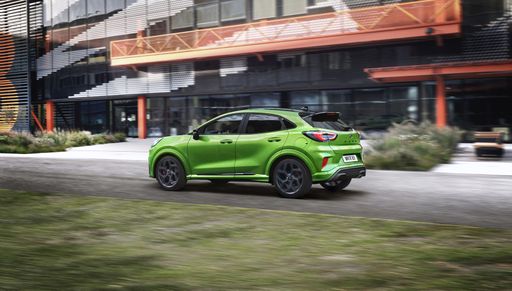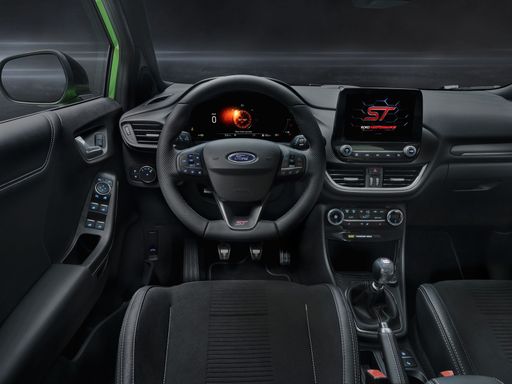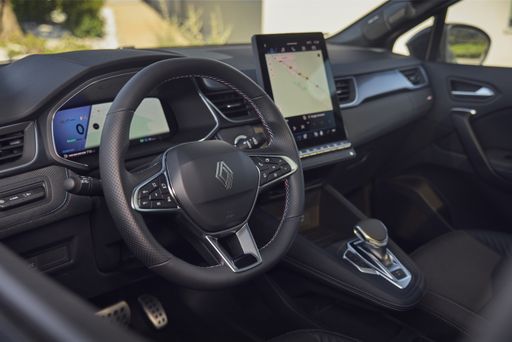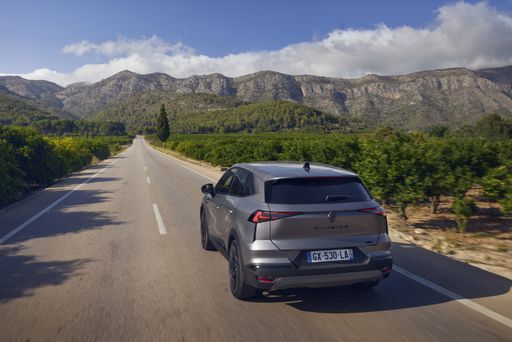Ford Puma vs Renault Symbioz – Which model is better for everyday use?
Everyday use, family trips or long-distance drives – here’s where the differences show.
Discover whether Ford Puma or Renault Symbioz fits your lifestyle better.
Costs and Efficiency:
Price and efficiency are key factors when choosing a car – and this is often where the real differences emerge.
Renault Symbioz has a minimal advantage in terms of price – it starts at 24400 £, while the Ford Puma costs 24800 £. That’s a price difference of around 343 £.
Fuel consumption also shows a difference: Renault Symbioz manages with 4.50 L and is therefore distinct more efficient than the Ford Puma with 5.40 L. The difference is about 0.90 L per 100 km.
Engine and Performance:
Power, torque and acceleration are the classic benchmarks for car enthusiasts – and here, some clear differences start to show.
When it comes to engine power, the Ford Puma has a slight edge – offering 168 HP compared to 158 HP. That’s roughly 10 HP more horsepower.
In acceleration from 0 to 100 km/h, the Ford Puma is distinct quicker – completing the sprint in 7.40 s, while the Renault Symbioz takes 9.10 s. That’s about 1.70 s faster.
In terms of top speed, the Ford Puma performs to a small extent better – reaching 210 km/h, while the Renault Symbioz tops out at 180 km/h. The difference is around 30 km/h.
There’s also a difference in torque: Ford Puma pulls hardly perceptible stronger with 290 Nm compared to 265 Nm. That’s about 25 Nm difference.
Space and Everyday Use:
Beyond pure performance, interior space and usability matter most in daily life. This is where you see which car is more practical and versatile.
Both vehicles offer seating for 5 people.
In curb weight, Ford Puma is slight lighter – 1316 kg compared to 1359 kg. The difference is around 43 kg.
In terms of boot space, the Renault Symbioz offers barely noticeable more room – 576 L compared to 523 L. That’s a difference of about 53 L.
In maximum load capacity, the Renault Symbioz performs evident better – up to 1682 L, which is about 399 L more than the Ford Puma.
When it comes to payload, Ford Puma minimal takes the win – 469 kg compared to 459 kg. That’s a difference of about 10 kg.
Who wins the race?
The Renault Symbioz proves to be dominates this comparison and therefore becomes our DriveDuel Champion!
Renault Symbioz is the better all-rounder in this comparison.
 @ Renault Group Media
@ Renault Group Media
Renault Symbioz
Ford Puma
The Ford Puma is a cheeky compact crossover that blends sporty styling with city-friendly practicality, giving drivers a surprisingly fun and composed ride. With clever storage tricks and a lively personality, it’s a smart pick for buyers who want enjoyment without fuss.
details @ Ford Motor Company / Ford Media Center
@ Ford Motor Company / Ford Media Center
 @ Ford Motor Company / Ford Media Center
@ Ford Motor Company / Ford Media Center
 @ Ford Motor Company / Ford Media Center
@ Ford Motor Company / Ford Media Center
 @ Ford Motor Company / Ford Media Center
@ Ford Motor Company / Ford Media Center
Renault Symbioz
The Renault Symbioz feels less like a traditional car and more like a rolling living room that's been told it's allowed to drive — its flowing lines and minimalist cabin are pure concept-car theatre that teases the future of everyday transport. For buyers with an eye for design and a taste for tech-forward ideas, the Symbioz is an alluring vision of what Renault could offer tomorrow, even if it's not yet a model you can park in your driveway.
details @ Renault Group Media
@ Renault Group Media
 @ Renault Group Media
@ Renault Group Media
 @ Renault Group Media
@ Renault Group Media
 @ Ford Motor Company / Ford Media Center
@ Ford Motor Company / Ford Media Center
|
 @ Renault Group Media
@ Renault Group Media
|
|
|
|
Costs and Consumption |
|
|---|---|
|
Price
24800 - 36300 £
|
Price
24400 - 30700 £
|
|
Consumption L/100km
5.4 - 5.9 L
|
Consumption L/100km
4.5 - 6 L
|
|
Consumption kWh/100km
13.1 - 13.9 kWh
|
Consumption kWh/100km
-
|
|
Electric Range
361 - 376 km
|
Electric Range
-
|
|
Battery Capacity
43 kWh
|
Battery Capacity
-
|
|
co2
0 - 135 g/km
|
co2
102 - 136 g/km
|
|
Fuel tank capacity
42 L
|
Fuel tank capacity
48 L
|
Dimensions and Body |
|
|---|---|
|
Body Type
SUV
|
Body Type
SUV
|
|
Seats
5
|
Seats
5
|
|
Doors
5
|
Doors
5
|
|
Curb weight
1316 - 1563 kg
|
Curb weight
1359 - 1544 kg
|
|
Trunk capacity
456 - 523 L
|
Trunk capacity
492 - 576 L
|
|
Length
4186 - 4226 mm
|
Length
4413 mm
|
|
Width
1805 mm
|
Width
1797 mm
|
|
Height
1550 - 1555 mm
|
Height
1575 mm
|
|
Max trunk capacity
1216 - 1283 L
|
Max trunk capacity
1582 - 1682 L
|
|
Payload
367 - 469 kg
|
Payload
376 - 459 kg
|
Engine and Performance |
|
|---|---|
|
Engine Type
Electric, Petrol MHEV
|
Engine Type
Full Hybrid, Petrol MHEV
|
|
Transmission
Automatic, Manuel
|
Transmission
Automatic, Manuel
|
|
Transmission Detail
Reduction Gearbox, Manual Gearbox, Dual-Clutch Automatic
|
Transmission Detail
Automatic Gearbox, Manual Gearbox, Dual-Clutch Automatic
|
|
Drive Type
Front-Wheel Drive
|
Drive Type
Front-Wheel Drive
|
|
Power HP
125 - 168 HP
|
Power HP
140 - 158 HP
|
|
Acceleration 0-100km/h
7.4 - 9.8 s
|
Acceleration 0-100km/h
9.1 - 11 s
|
|
Max Speed
160 - 210 km/h
|
Max Speed
180 km/h
|
|
Torque
170 - 290 Nm
|
Torque
250 - 265 Nm
|
|
Number of Cylinders
3
|
Number of Cylinders
4
|
|
Power kW
92 - 124 kW
|
Power kW
103 - 116 kW
|
|
Engine capacity
999 cm3
|
Engine capacity
1332 - 1789 cm3
|
General |
|
|---|---|
|
Model Year
2025
|
Model Year
2025
|
|
CO2 Efficiency Class
A, D
|
CO2 Efficiency Class
C, D, E
|
|
Brand
Ford
|
Brand
Renault
|
Is the Ford Puma offered with different drivetrains?
The Ford Puma is offered with Front-Wheel Drive.
The prices and data displayed are estimates based on German list prices and may vary by country. This information is not legally binding.
